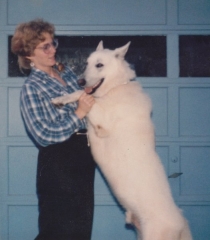Stopping Jumping
Teaching your dog not to jump is a form of boundary training. Boundary training is essentially a dogs understanding not to cross any threshold without permission. The key to a dog’s understanding boundary training is the timing of the correction. You need to do the correction as your dog is actually starting to jump. Then praise your dog as soon as they are down. Before you begin training you may decide to make a choice on what your policy will be for jumping.
Your choices are:
#1 – No jumping at all, ever,
#2 – No jumping, except when invited, or
#3 – Jumping is OK except when told not to (this option is most appropriate for small dogs).
If you choose choice #1 (no jumping at all), then the correction needs to take place right away as your dog jumps. If you tell your dog to get down as they are jumping, then they’re understanding will be that’s it’s OK to get one free jump before getting down. If you approach it this way you are really teaching your dog choice #3.
If you choose choice #2 approach it the same way you would for choice #1 except you teach your dog an invitation to jump up, like patting your chest with the word “OK”.
If you choose choice #3; pick a command that means to stop like “Off” or “NO jump”. As you say this pull your dog gently off, or push them off. If your dog jumps after you place them off, use a correction and repeat your command.
You need to find a correction that will be effective for your dog. Here are some suggestions.
Mild
- A shake can (a can with about 10 pennies taped closed).
- A plant mister bottle adjusted to a jet stream.
- Bang the wall with a magazine.
- A leash correction
Moderate
- Using a harder leash correction.
- Dropping a aluminum baking sheet near your dogs feet
- Using a throw chain; a chain (like what is used to hang plants or chandeliers) in a circle configuration
Headstrong
- A series of leash corrections
- Using a collar right behind your dogs ears (either use a snap back collar, or place the slip collar high on your dogs neck)
- Using a prong collar.
- Using a sound horn. This is a nautical device often use at sporting events and can be purchased where they sell sporting goods, or at a boat store.
- Using a remote collar (remote collars, or e-collars, can be adjusted from low to high and therefore can be used even with mild mannered dogs when used at the appropriate level)
Additional tips: Remember don’t keep your dog from starting to jump. The correction must take place while they are engaged in the jumping. Praise them when they are down on all fours but keep praise low key or it will encourage your dog to jump up again. This is important because we don’t want your dog to get confused and think want you want from them is to stay away from you or people all together. What we want is your dog to understand, you may say hello, but only when not jumping and are staying on all fours in a mannerly fashion. Practice by using helpers. The helper will tempt the dog to jump by a friendly, but not overly enthusiastic greeting, acting as most people behave when meeting a dog. Have someone talk to your dog as you prepare to give the correction. Instruct the helper to calmly praise your dog when they are down. You do the correcting for jumping up. It is not reasonable to expect your visitors to correct your dog for you.
If you are using leash corrections make sure you hold the leash short, but loose. Time the correction as you dog rears up. Use the leash corrections to the side to throw your dog off balance. Leash corrections are very effective and versatile, but you need to learn how to do them correctly.


